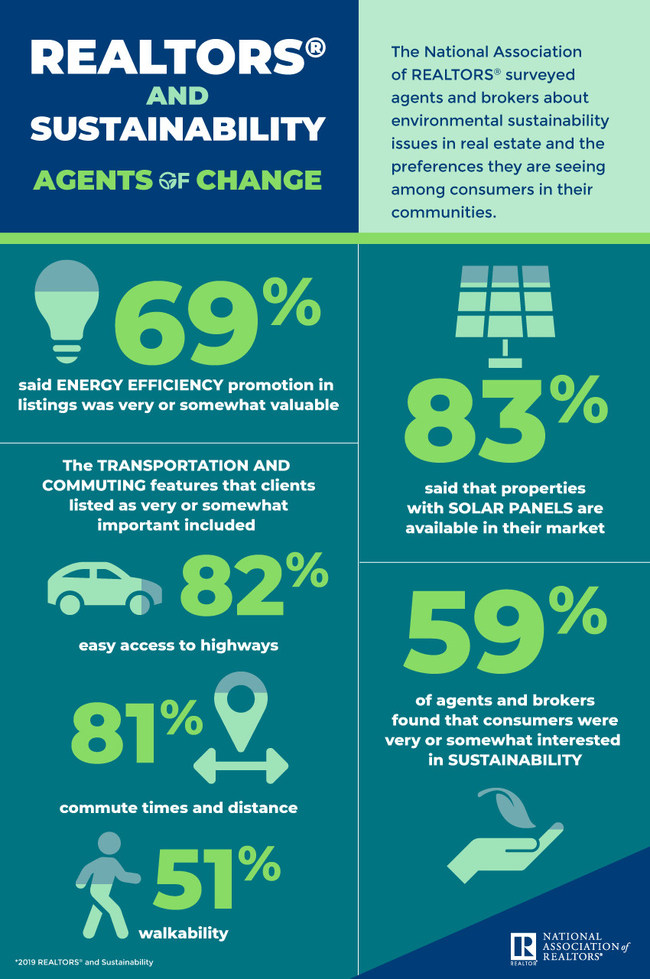Promoting Green Features in Both Residential and Commercial Listings
With Earth Day right around the corner, members of the National Association of Realtors® are doubling down on their commitment to promote environmentally friendly home features, adopt green business practices and encourage a culture of sustainability in real estate. With this in mind, NAR is releasing the REALTORS® and Sustainability 2019 Report, which found that consumer demand in real estate continues to trend eco-friendly.

NAR 2019 Sustainability Infographic
The report, found at www.nar.realtor/research-and-statistics/research-reports/realtors-and-sustainability, is in its third iteration and stems from NAR’s Sustainability Program. It surveyed Realtors® about sustainability issues in the residential and commercial real estate markets and the preferences they are seeing in consumers in their communities.
According to the report, 59% of respondents found that residential consumers were very or somewhat interested in sustainability. Seven in 10 residential and commercial agents and brokers reported that promoting energy efficiency in listings is either somewhat or very valuable.
“The state of the environment is important to our members and their business practices, and the report shows that sustainability impacts consumers’ home buying decisions as well,” said NAR President John Smaby, a second-generation Realtor® from Edina, Minnesota and broker at Edina Realty. “Realtors® remain on the cutting edge of sustainability and continue to lead the conversation about energy efficiency in real estate.”
A large majority of respondents (83%) said that solar panels were available in their markets, and 36% said that solar panels increased the perceived property value. However, only 8% of those surveyed said that solar panels decreased the perceived amount of time a home spent on the market. Solar panels are most prevalent in Northeast (available in 94% of markets) and respondents in the West were the most likely to report they increase perceived property value (41%).
Twenty-five percent of brokers indicated that tiny homes – homes that are 600 square feet or less – are available in their markets, a 2% increase from 2018. Only 13% of respondents said that wind farms were available in their markets.
The transportation and commuting features that Realtors® stated are very or somewhat important to their clients include: easy access to highways (82%), short commute times and distance to work (81%) and walkability (51%) – the same as 2018.
Forty-one percent of respondents were aware that their Multiple Listing Service, or MLS, has green data fields, compared to only 14% that were unaware. Among those that do have green data fields, 35% of respondents use them to promote green features, 26% use to promote energy information and 14% use to promote green certifications.
Realtors® also revealed how comfortable they are answering questions about home performance and efficiency; 39% said they are comfortable or extremely comfortable. Forty percent of respondents say they are confident or extremely confident in their ability to connect clients with green lenders; only 6% responded that they are not at all confident.
When asked what they consider as the top market issues and considerations regarding sustainability, agents and brokers named understanding lending options for energy upgrades or solar panels (38%), the lack of information and materials provided to real estate professionals (32%) and improving the energy efficiency of existing housing stock (31%).
Respondents were also asked about sustainability in commercial real estate. Seventy percent of agents and brokers indicated that promoting energy efficiency in their commercial listings was very or somewhat valuable. Sixteen percent of respondents reported that their Commercial Information Exchange had green data fields and that those fields promote energy information and green features. The top building features that clients specified as very or somewhat important to their agents or brokers were utility/operation costs (81%), efficient use of lighting (67%) and indoor air quality (64%).
NAR initiated the Sustainability Program as a platform for dialogue on sustainability for Realtors®, brokers, allied trade associations, and consumers. The program’s efforts focus on coordination and articulation of NAR’s existing sustainability resources, while also supporting a growing area of interest for consumers, helping members to assist home buyers and sellers.
The REALTOR® Sustainability Program invited a sample of 112,035 active Realtors® to participate in an online survey pertaining to sustainability issues facing consumers and the industry, resulting in 6,047 usable responses. NAR plans to use this report to better benchmark Realtor® understanding of sustainability and create resources to help Realtors®better serve clients surrounding sustainability topics.
